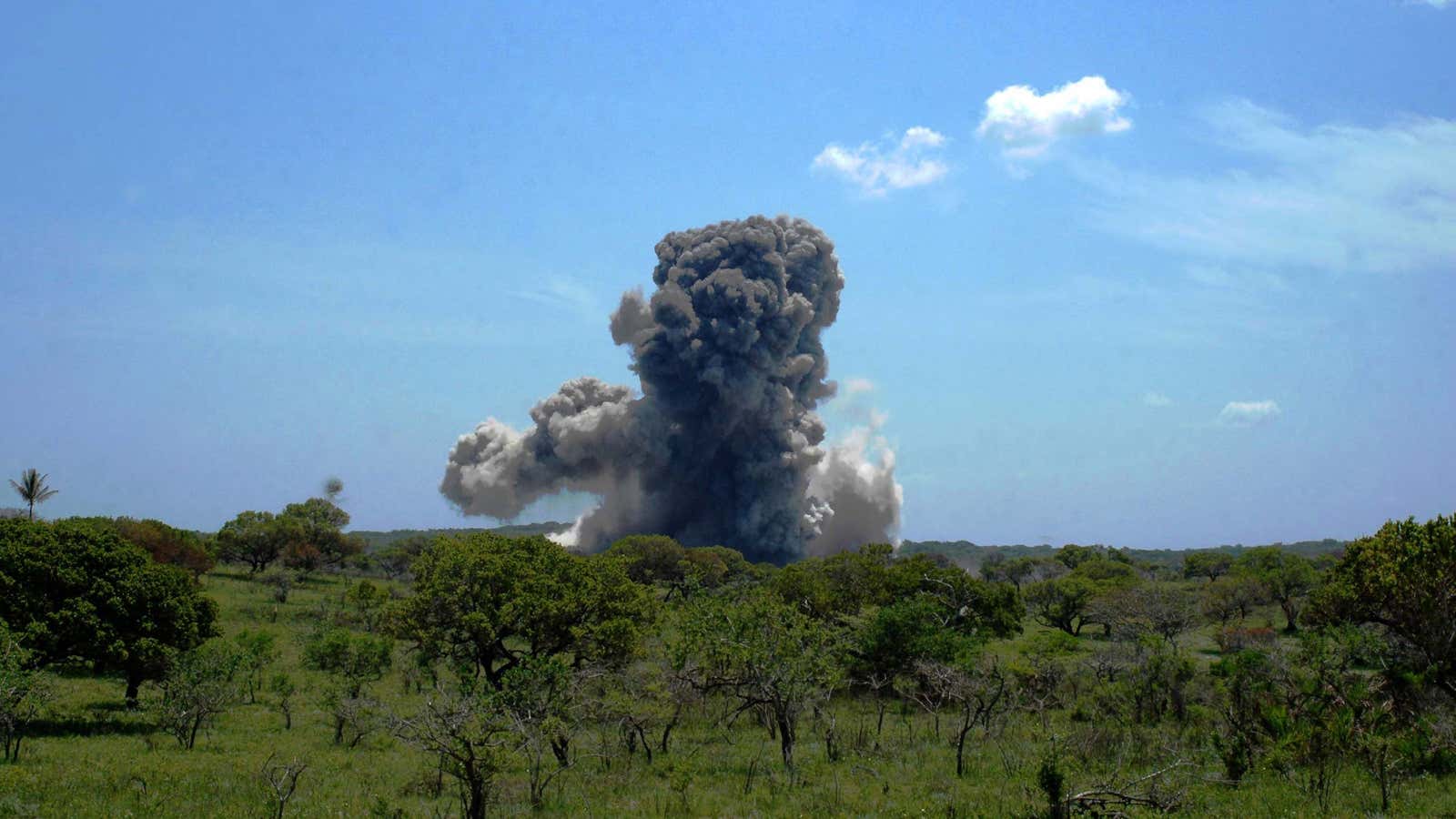Three years ago, Mozambique became the first heavily mined country to be declared landmine-free. This was hailed as a big humanitarian victory: over the course of 23 years, more than 300,000 explosive devices—the legacy of three decades of war—were successfully destroyed by the UN and other agencies.
But Mozambique’s feat is a great economic story as well, it now appears. In a new paper, scholars from London Business School and Brown University estimate the nation’s GDP would have been up to 25% lower in 2015 without demining.
Yet African countries looking to replicate Mozambique’s success face an uphill struggle. Angola, where 221 square kilometers of land is still contaminated, remains far behind its target of becoming landmine-free by 2025. MAG, a UK-based NGO, estimates the country needs seven times more funding than it currently gets to achieve this goal. International support has reduced by nearly two-thirds since 2012; national contributions have halved in just a year.
Angola is not alone. Heavily mined countries such as Chad, Ethiopia, South Sudan and Eritrea aren’t on track to achieve their demining goals, according to the Landmine and Cluster Munition Monitor. Zimbabwe has extended its original 2018 deadline by another eight years. Somalia and Senegal, where the extent of contamination remains unclear, are also lagging.
Dwindling international support is partly to blame. “We are witnessing a donor fatigue,” says Emmanuel Sauvage of Humanity & Inclusion, which played a key role in Mozambique’s clearance efforts. “Countries like Chad, Senegal or the DRC could achieve mine-free status, but they are being somewhat penalized. Conflicts in the Middle East are absorbing nearly all funding for the sector.”
In Iraq, Syria and Libya, demining is urgently needed: refugees are returning home en masse and swift action can save many lives. But Chris Loughran, MAG’s director of policy and advocacy, warns that “Africa is the continent that risks being forgotten.” While 2016 saw the highest level of funding for demining on record globally, he says, Africa recorded a dip
The research could help reverse that trend. “Mine action is often a bit of an after-thought,” says Camille Wallen, head of policy and evaluation at the Halo Trust, the first NGO to demine in Mozambique. “It’s not thought of as an integral part of a country’s national development process.” By tying demining to economic growth, Giorgio Chiovelli, Stelios Michalopoulos and Elias Papaioannou, the paper’s co-authors, hope to persuade a larger pool of donors.
Yet the three researchers want to go even further. Demining is already doing good where it happens, they say—but it could do better.
The authors argue program leaders should put more thought into where to demine first. When landmines are removed in a particular area, local economic activity gets a small boost, the paper says. But other areas that are connected to it benefit as well—even if they don’t host mines themselves. Those “spillover effects” tend to be especially large when mines that block roads and railways are cleared: goods can flow and markets can restart. Clearing “strategic central nodes” first can unlock big economic gains, the scholars reckon.
“In aggregate, demining provides a huge economic boost. This indirect effect is something governments and demining agencies have totally missed,” says Papaioannou.
These findings are encouraging, but face several practical hurdles, notes Johan Van Den Heever, director of Demining Enterprises International. It can take many years to map out contaminated areas; decision-making is often fragmented between local authorities, donors and demining agencies. Once humanitarian emergencies have been addressed, who is to decide where to demine first? “Competition in demining is not particularly good,” Papaioannou notes. Things work best when a central authority is established to co-ordinate efforts, he argues, as was the case in Mozambique after 1999.
Clearer prioritization would help convince donors their money is put to good use. But Sauvage says support must also come from home. “It’s also the government’s responsibility to invest in demining, and the private sector too can contribute. The international community simply can’t fund every mine clearance effort on its own.”
